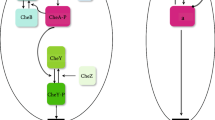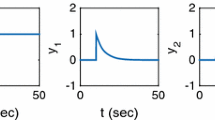Abstract
Chemotaxis models are based on spatial or temporal gradient measurements by individual organisms. The key contribution of Keller and Segel (J Theor Biol 30:225–234, 1971a; J Theor Biol 30:235–248, 1971b) is showing that erratic measurements of individuals may result in an accurate chemotaxis phenomenon as a group. In this paper we provide another option to understand chemotactic behavior when individuals do not sense the gradient of chemical concentration by any means. We show that, if individuals increase their dispersal rate to find food when there is not enough food, an accurate chemotactic behavior may be obtained without sensing the gradient. Such a dispersal has been suggested by Cho and Kim (Bull Math Biol 75:845–870, 2013) and was called starvation driven diffusion. This model is surprisingly similar to the original Keller–Segel model. A comprehensive picture of traveling bands and fronts is provided.





Similar content being viewed by others
References
Adler J (1966) Chemotaxis in bacteria. Science 153:708–716
Adler J (1969) Chemoreceptors in bacteria. Science 166:1588
Bonner JT (1967) The cellular slime molds, 2nd edn. Princeton University Press, Princeton
Chaplain MAJ (1996) Avascular growth, angiogenesis and vascular growth in solid tumors: the mathematical modelling of the stages of tumor development. Math Comput Model 23:47–87
Cho E, Kim Y-J (2013) Starvation driven diffusion as a survival strategy of biological organisms. Bull Math Biol 75(5):845–870 (MR 3050058)
Condeelis J, Singer RH, Segall JE (2005) The great escape: when cancer cells hijack the genes for chemotaxis and motility. Annu Rev Cell Dev Biol 21:695–718
Condeelis J, Pollard JW (2006) Macrophages: obligate partners for tumor cell migration, invasion, and metastasis. Cell 124:263–266
Corrias L, Perthame B, Zaag H (2003) A chemotaxis model motivated by angiogenesis. C R Math Acad Sci Paris 336(2):141–146 [MR 1969568 (2004c:92004)]
Corrias L, Perthame B, Zaag H (2004) Global solutions of some chemotaxis and angiogenesis systems in high space dimensions. Milan J Math 72:1–28 [MR 2099126 (2005f:35135)]
Dormann D, Weijer CJ (2006) Chemotactic cell movement during dictyostelium development and gastrulation. Curr Opin Genet Dev 16(4):367–373
Ebihara Yukiyoshi, Furusho Yasuhiro, Nagai Toshitaka Singular (1992) solutions of traveling waves in a chemotactic model. Bull Kyushu Inst Tech Math Nat Sci 39:29–38 [MR 1167896 (93f:92012)]
Hildebrand E, Kaupp UB (2005) Sperm chemotaxis: a primer. Ann N Y Acad Sci 1061:221–225
Hillen T, Painter KJ (2009) A user’s guide to PDE models for chemotaxis. J Math Biol 58:1–2, 183–217 [MR 2448428 (2009m:92017)]
Jin H-Y, Li J, Wang Z-A (2013) Asymptotic stability of traveling waves of a chemotaxis model with singular sensitivity. J Differ Equ 255(2):193–219 (MR 3047400)
Keller EF, Segel LA (1971a) Model for chemotaxis. J Theor Biol 30(2):225–234
Keller EF, Segel LA (1971b) Traveling bands of chemotactic bacteria: a theoretical analysis. J Theor Biol 30(2):235–248
Keller Evelyn F, Odell Garrett M (1975) Necessary and sufficient conditions for chemotactic bands. Math Biosci 27(3/4):309–317 [MR 0411681 (53 #15411)]
Lapidus JR, Schiller R (1978) A model for traveling bands of chemotactic bacteria. J Theor Biol 22:1–13
Larrivee B, Karsan A (2000) Signaling pathways induced by vascular endothelial growth factor (review). Int J Mol Med 5(5):447–456
Levine Howard A, Sleeman Brian D, Nilsen-Hamilton M (2001) Mathematical modeling of the onset of capillary formation initiating angiogenesis. J Math Biol 42(3):195–238 [MR 1828815 (2003b:92003)]
Li T, Wang Z-A (2009/10) Nonlinear stability of traveling waves to a hyperbolic-parabolic system modeling chemotaxis. SIAM J Appl Math 70(5):1522–1541 [MR 2578681 (2011d:35308)]
Li T, Wang Z-A (2012) Steadily propagating waves of a chemotaxis model. Math Biosci 240(2):161–168 (MR 3000369)
Lui R, Wang ZA (2010) Traveling wave solutions from microscopic to macroscopic chemotaxis models. J Math Biol 61(5):739–761 [MR 2684162 (2011m:92019)]
Matsushita M, Wakita J, Itoh H, Watanabe K, Arai T, Matsuyama T, Sakaguchi H, Mimura M (1999) Formation of colony patterns by a bacterial cell population. Phys A 274(1–2):190–199
Nagai T, Ikeda T (1991) Traveling waves in a chemotactic model. J Math Biol 30(2):169–184 [MR 1138847 (93b:92014)]
Okubo A, Levin Simon A (2001) Diffusion and ecological problems: modern perspectives, 2nd edn. In: Interdisciplinary applied mathematics, vol 14. Springer, New York [MR 1895041 (2003a:92025)]
Rosen G (1974) On the propagation theory for bands of chemotactic bacteria. Math Biosci 20:185–189
Rosen G (1975) Analytically solution to the initial-value problem for traveling bands of chemotaxis bacteria. J Theor Biol 49:311–321
Rosen G (1975) On the stability of steadily propagating bands of chemotactic bacteria. Math Biosci 24:273–279
Rosen G, Baloga S (1978) Steady-state distribution of bacteria chemotaxis toward oxygen. Bull Math Biol 40:671–674
Tindall MJ, Maini PK, Porter SL, Armitage JP (2008) Overview of mathematical approaches used to model bacterial chemotaxis. II. Bacterial populations. Bull Math Biol 70(6):1570–1607 [MR 2430318 (2009i:92012b)]
Tindall MJ, Porter SL, Maini PK, Gaglia G, Armitage JP (2008) Overview of mathematical approaches used to model bacterial chemotaxis. I. The single cell. Bull Math Biol 70(6):1525–1569 [MR 2430317 (2009i:92012a)]
Wang Z, Hillen T (2008) Shock formation in a chemotaxis model. Math Methods Appl Sci 31(1):45–70 [MR 2373922 (2009e:35177)]
Xue C, Ju HH, Painter KJ, Erban R (2011) Travelling waves in hyperbolic chemotaxis equations. Bull Math Biol 73(8):1695–1733 [MR 2817814 (2012g:92035)]
Acknowledgments
Anonymous reviewers suggestions improved this article and are greatly appreciated. This work has been supported in part by National Research Foundation of Korea (No. 013-2011-1-C00002).
Author information
Authors and Affiliations
Corresponding author
Appendix A: Derivation of a starvation driven diffusion
Appendix A: Derivation of a starvation driven diffusion
In this section we introduce a short derivation of a starvation driven diffusion (see Cho and Kim 2013, for detailed discussions). Consider a random walk system with a constant walk length \(\Delta x\) and a constant jumping time interval \(\Delta t\). Let \(0<\gamma (x_i)\le 1\) be the probability for a particle to depart a grid point \(x_i\) at each jumping time. (For a usual random walk system every particle departs at each jumping time and hence \(\gamma =1\).) Each particle moves to one of two adjacent grid points, \(x_{i+1}\) or \(x_{i-1}\), randomly. Let \(U(x_i)\) be the number of particles placed at the grid point \(x_i\). Then, the particle density is \(u=U/\Delta x\). Hence the net flux that crosses a middle point \(x_{i+1/2}:={x_i+x_{i+1}\over 2}\) is
The corresponding diffusion equation comes from the conservation law
After a time rescaling we obtain the desired equation
Notice that the probability \(\gamma \) depends only on the departing point \(x_i\), which indicates the concentration gradient is not measured. If the probability depends on nearby points, then it implies gradient information is used to decide the migration probability. For more discussion including other cases, see Okubo and Levin (2001, §5.4).
Rights and permissions
About this article
Cite this article
Yoon, C., Kim, YJ. Bacterial chemotaxis without gradient-sensing. J. Math. Biol. 70, 1359–1380 (2015). https://doi.org/10.1007/s00285-014-0790-y
Received:
Revised:
Published:
Issue Date:
DOI: https://doi.org/10.1007/s00285-014-0790-y
Keywords
- Chemotaxis
- Phase plane analysis
- Starvation driven diffusion
- Keller–Segel equation
- Pulse and front type traveling waves




